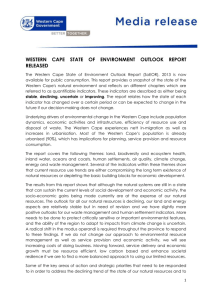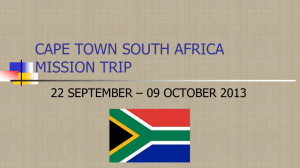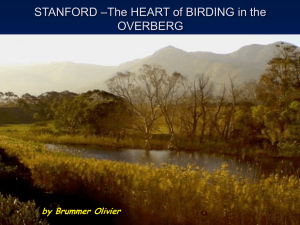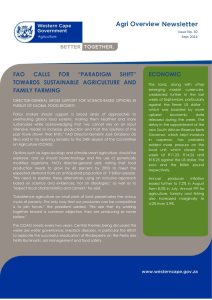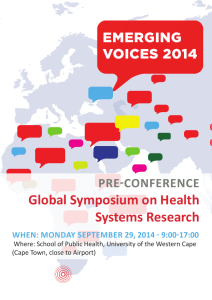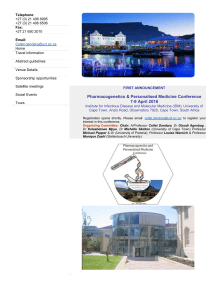8-day Western Cape, South Africa, Birding
advertisement
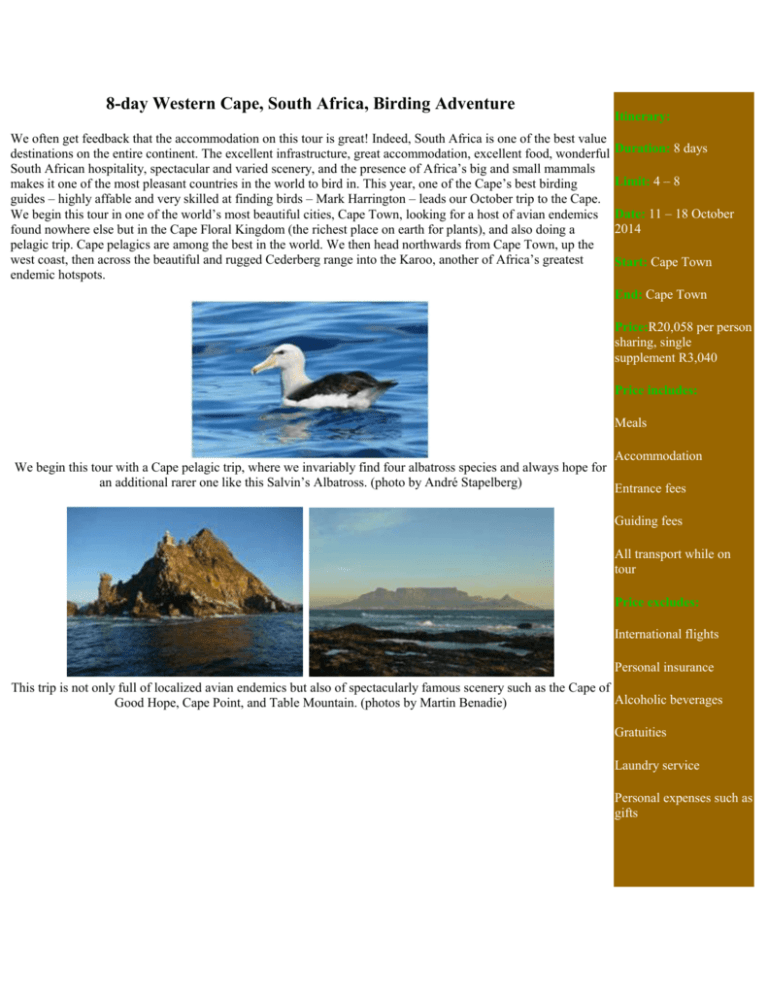
8-day Western Cape, South Africa, Birding Adventure We often get feedback that the accommodation on this tour is great! Indeed, South Africa is one of the best value destinations on the entire continent. The excellent infrastructure, great accommodation, excellent food, wonderful South African hospitality, spectacular and varied scenery, and the presence of Africa’s big and small mammals makes it one of the most pleasant countries in the world to bird in. This year, one of the Cape’s best birding guides – highly affable and very skilled at finding birds – Mark Harrington – leads our October trip to the Cape. We begin this tour in one of the world’s most beautiful cities, Cape Town, looking for a host of avian endemics found nowhere else but in the Cape Floral Kingdom (the richest place on earth for plants), and also doing a pelagic trip. Cape pelagics are among the best in the world. We then head northwards from Cape Town, up the west coast, then across the beautiful and rugged Cederberg range into the Karoo, another of Africa’s greatest endemic hotspots. Itinerary: Duration: 8 days Limit: 4 – 8 Date: 11 – 18 October 2014 Start: Cape Town End: Cape Town Price:R20,058 per person sharing, single supplement R3,040 Price includes: Meals Accommodation We begin this tour with a Cape pelagic trip, where we invariably find four albatross species and always hope for an additional rarer one like this Salvin’s Albatross. (photo by André Stapelberg) Entrance fees Guiding fees All transport while on tour Price excludes: International flights Personal insurance This trip is not only full of localized avian endemics but also of spectacularly famous scenery such as the Cape of Alcoholic beverages Good Hope, Cape Point, and Table Mountain. (photos by Martin Benadie) Gratuities Laundry service Personal expenses such as gifts A desert bird that skulks - watch this weird little warbler disappear into a rock crevice! Cinnamon-breasted Warbler is one of the Cape’s strangest endemics and is one of the toughest of the many Karoo endemics to see well. (photo by André Stapelberg) Cape Rockjumper has a beautiful call, striking colors, a boisterous personality and a terribly limited distribution around Cape Town. What more can you possibly ask for? (photo by André Stapelberg) All in all, our 8-day Cape tour is full of localized endemics, spectacular scenery, and so much more. This is where Birding Ecotours started as a company, 10 years ago, and nowhere else do we have as much experience as in the Cape. A terrestrial woodpecker, Ground Woodpecker (photo by Martin Benadie) and African Penguin (photo by Chris Lotz) are found on the spectacular Cape Peninsula – the woodpecker shown here has the sea as a backdrop, with high mountains behind the photographer The Kirstenbosch Botanical Gardens have plenty of birds. (photo by Chris Lotz) The Western Cape is the most important endemic bird area on the entire African continent! It is a truly essential area for any serious birder because of its sheer number of endemics. Pelagic trips off Cape Town also rank as among the finest in the world (with at least four albatross species, Pintado Petrel, and many more on the rich trawling grounds near where two oceans meet). The Cape is also a spectacularly scenic area, with the rugged Cape Fold Mountains that come right down to the sea, white sand beaches, sea cliffs on the Cape Peninsula, and beautiful vineyards. Close inshore southern right whales (seasonal) plus a lot of other mammals, spectacular carpets of flowers (seasonal), and the most plantdiverse biome on earth (even richer than the Amazon!) are major attractions that are easily seen incidentally, while not jeopardizing our chances of finding all the birds. We recommend at least a week in the Western Cape. The aim of our standard (set departure) 8-day tour (but we can custom-make a trip of any length) is to find a majority of the endemics of this province, with many other species as an unavoidable byproduct (plus, as always, an amazing overall experience), and of course a lot of pelagic and other seabirds. To find the endemics, we budget adequate time in each strategic ecosystem – the fynbos, Langebaan Lagoon, and the Karoo. This tour can be combined with our 16-day subtropical South Africa Birding Adventure. Please note that the detailed itinerary below cannot be guaranteed as it is only a rough guide and can be changed (usually slightly) due to factors such as availability of accommodation, updated information on the state of accommodation, roads, or birding sites, the discretion of the guides and other factors. Itinerary (8 days/7 nights) Day 1. Arrival in Cape Town This is the day you need to arrive in Cape Town – any time during the day. You will be met at Cape Town International Airport and transferred to Afton Grove B&B. Time-permitting, we may already start some birding today – we can bird one of the Cape Peninsula’s fine wetlands (Intaka Island, Rietvlei or Rondevlei). Here we will look for Great White Pelican, Greater Flamingo, a host of shorebirds, Cape Teal and Maccoa Duck among many other waterfowl, Little Bittern and many other herons, three grebe species, Greater Paintedsnipe, African Snipe, four species of reed-associated Warblers, and other waterbirds. While looking for waterbirds (or even while driving to our B&B), we should also find good numbers of terrestrial endemics, including Karoo Prinia, Cape Bulbul, and Jackal Buzzard. Overnight: at the lovely “birder-friendly” Afton Grove B&B Day 2. Pelagic trip (or Cape Peninsula and False Bay birding) After an early breakfast, we embark on a pelagic trip (weather-permitting, otherwise Cape Peninsula and False Bay birding), departing from Simonstown, where we will find African Penguin, from here going 30-50 km out to sea. En route, we pass the magnificent Cape Point – really spectacular when seen from the sea. Our first pelagic species are usually Sooty Shearwater and White-chinned Petrel (with the occasional Spectacled Petrel), followed soon by sometimes both species of Giant Petrel, Northern and Southern. Further out, a minimum of four Albatross species, Pintado and other Petrels, several Storm Petrels (two species are usually common), shearwaters and many others are observed. We almost always find at least one trawler, and it is around these fishing boats that huge congregations of albatrosses and other seabirds create an amazing spectacle. We also often encounter marine mammals such as Bryde’s whale on these pelagics. Overnight: Afton Grove B&B Day 3. Birding the Cape Peninsula and False Bay (or Pelagic trip) We begin our Cape Peninsula birding at the Constantia Greenbelt, where the most strategic species is the endangered, localized, skulking Knysna Warbler. This warbler has a really beautiful call but is rather disappointing in appearance. While looking for this bird, we may find Buff-spotted Flufftail (with luck), African Olive (Rameron) Pigeon, Red-chested Cuckoo, the attractive Cape Batis, and other good birds. After about an hour’s birding here, we will visit the nearby Kirstenbosch Botanical Gardens, one of the most beautiful places anywhere, and full of birds. Here it is quite easy to find some important fynbos endemics such as Orange-breasted Sunbird and Cape Sugarbird, while Cape Spurfowl, Southern Boubou, Cape Canary, Brimstone Canary, Cape Robin-Chat, Swee Waxbill (with luck), and a whole host of other quality birds entertain us. Many raptors are possible here and at other sites we will visit – including Verreaux’s (Black) Eagle, several exciting accipiters, Jackal Buzzard (endemic), Forest Buzzard (endemic), Peregrine Falcon, Rock Kestrel, and others. After birding these beautiful gardens, we depart for Rooiels. To get to this village, we have to traverse one of the most scenic drives in South Africa along the False Bay coast. First we drive parallel to an extremely long white beach bordering the “Cape Flats” that separate the mountainous Cape Peninsula from the inland Cape Fold mountain ranges. Then we reach an Cape Sugarbird area where impressive mountains meet the sea to begin a truly stunning marine drive. The main target bird at Rooiels is the charismatic and localized Cape Rockjumper. But we should also find Cape Siskin, Cape Rock Thrush, and many more. On our return to the Cape Peninsula, timepermitting (else later in the itinerary), we can bird the superb Strandfontein Bird Sanctuary for a plethora of herons, reed-associated warblers, waterfowl, shorebirds, African Black Oystercatcher, Purple Swamphen, Great White Pelican, Greater Flamingo, African Marsh Harrier, and (as usual) many others. Overnight: Afton Grove B&B Day 4. West Coast Birding Today we begin an exciting birding journey northwards from Cape Town. We hope to find Black Harrier, Chestnut-banded Plover, Cape Penduline Tit, Cape Clapper Lark, Cape Long-billed Lark, Grey-winged Francolin, Southern Black Korhaan, and other specials in addition to a tremendous shorebird spectacle. Langebaan Lagoon is one of Africa’s most important shorebird stopover sites, and there are good hides (blinds) from which to observe the spectacle. We may also find Osprey, African Fish Eagle, and many others. Overnight: Glennfinnan Guest House, Langebaan Day 5. Transfer to the Karoo via the Cederberg Mountains Today we head inland over the magnificent Cederberg Mountain Range. On the way we have an excellent site for the tough Protea Canary. On the summit, we have a second chance for Cape Rockjumper on the off-chance that it was missed at Rooiels. We may also find Ground Woodpecker, European Bee-eater, and other spectacular species. But we have to get to the eastern (rain-shadow) side of the mountains to get to the famed (amongst birders) Karoo. Here, almost every species encountered is endemic, so it makes for spectacularly exciting birding for any serious birder who has never visited this particular semi-desert. Overnight: Village B&B, Ceres, or Tanqua B&B, Route 355 Day 6. Birding the Karoo A full day of Karoo birding. The pickings here include the likes of Cinnamon-breasted Warbler (a truly bizarre rock crevice skulker), Namaqua Warbler, the lovely Rufous-eared Warbler, Black-headed Canary, Whitethroated Canary, Fairy Flycatcher, Southern Grey Tit, Karoo Chat, Sickle-winged Chat, Tractrac Chat, Karoo Lark, Karoo Long-billed Lark, Spike-heeled Lark, Large-billed Lark, Karoo Eremomela, Pririt Batis, Burchell’s Courser, Double-banded Courser, Ludwig’s Bustard, Karoo Korhaan, Pale Chanting Goshawk, Namaqua Sandgrouse, Namaqua Dove, and many others. Overnight: Village B&B, Ceres Day 7. Transfer to Cape Town We will drive back to Cape Town, birding at Paarl en route for fynbos species and those waterbirds we are still missing. A night back on the Cape Peninsula will give us time to find some of the Cape’s more difficult species. Overnight: Afton Grove B&B Day 8. Departure We may be able to do some final Cape Peninsula birding before you catch your flight to Durban to begin the Subtropical Leg of the tour, or your international flight leaves Cape Town, Blue Crane (photo by Adrian Binns) © 2002-2012 Birding Ecotours · www.birdingecotours.co.za · info@birdingecotours.co.za


